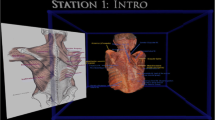Abstract
Virtual Reality is becoming widespread in our society within very different areas, from industry to entertainment. It has many advantages in education as well, since it allows visualizing almost any object or going anywhere in a unique way. We will be focusing on medical education, and more specifically anatomy, where its use is especially interesting because it allows studying any structure of the human body by placing the user inside each one. By allowing virtual immersion in a body structure such as the interior of the cranium, stereoscopic vision goggles make these innovative teaching technologies a powerful tool for training in all areas of health sciences. The aim of this study is to illustrate the teaching potential of applying Virtual Reality in the field of human anatomy, where it can be used as a tool for education in medicine. A Virtual Reality Software was developed as an educational tool. This technological procedure is based entirely on software which will run in stereoscopic goggles to give users the sensation of being in a virtual environment, clearly showing the different bones and foramina which make up the cranium, and accompanied by audio explanations. Throughout the results the structure of the cranium is described in detailed from both inside and out. Importance of an exhaustive morphological knowledge of cranial fossae is further discussed. Application for the design of microsurgery is also commented.






Similar content being viewed by others
References
Henn JS, Lemole GM, Jr, Ferreira MA, Gonzalez LF, Schornak M, Preul MC and Spetzler R (2002) Interactive stereoscopic virtual reality: A new tool for neurosurgical education: Technical note. J. Neurosurg. 96:144–149.
Quintero, C., Sarmiento, W.J., and Sierra-Ballén, E.L., Diseño de un prototipo de Sistema de Realidad Virtual Inmersivo Simplificado. En: Ciencia e Ingeniería Neogranadina. 18:35–50, 2008.
Kuntze MF, Stoermer R and Mager R (200) Immersive virtual environments in cues exposure. Cyberpsychology and Behavior 4: 497–501.
Van Dam, A., Laidlaw, D.H., and Simpson, R.M., Experiments in immersive virtual reality for scientific visualization. Comput. Graph. 26:535–555, 2002.
Häfner, P., Häfner, V., and Ovtcharova, J., Teaching methodology for virtual reality practical course in engineering education. Procedia - Procedia Comput. Sci. 25:251–260, 2013.
Sauter, P.M., VR2Go a new method for virtual reality development. En: ACM SIGGRAPH Comput. Graph. 37(1):19–24, 2003.
Nichols, S., and Patel, H., Health and safety implications of virtual reality: A review of empirical evidence. Appl. Ergon. 33:251–271, 2002.
Burdea, G., and Coiffet, P., Virtual reality technology. Presence Teleop. Virt. 12:663–664, 2003.
Kizony, R., and Katz, N., Adapting an immersive virtual reality system for rehabilitation. J. Vis. Comput. Animat. 14:261–268, 2003.
Johnsen, K., Dickerson, R., Raij, A., Lok, B., Jackson, J., Shin, M., and Lind, D. S., Experiences in using immersive virtual characters to educate medical communication skills. In Virtual Reality, In Proceedings IEEE. 179–186, 2005.
Psotka, J., Immersive training systems: Virtual reality and education and training. Instr. Sci. 23:405–431, 1995.
Kilteni, K., Normand, J.M., Sanchez-Vives, M.V., and Slater, M., Extending body space in immersive virtual reality: A very long arm illusion. PLoS One. 7:40867, 2012.
Chan, S., Conti, F., Salisbury, K., and Blevins, N.H., Virtual reality simulation in neurosurgery: Technologies and evolution. Neurosurgery. 72:154–164, 2013.
Stadie, A.T., Kockro, R.A., Reisch, R., Tropine, A., Boor, S., Stoeter, P., and Perneczky, A., Virtual reality system for planning minimally invasive neurosurgery. J. Neurosurg. 108:382–394, 2008.
Coleman, J., Nduka, C.C., and Darzi, A., Virtual reality and laparoscopic surgery. Br. J. Surg. 81:1709–1711, 1994.
Aman, S.M., Low cost virtual reality for medical training. IEEE Xplore Virtual Reality, 2015.
Acknowledgements
This project was possible thanks to the help of the ARSOFT company members, specialized in the implementation of advanced Virtual Reality systems. We also want to highlight the contribution of the research group VisualMed System, from the University of Salamanca for its active participation in the creation of the contents of the project as well as in the generation of the 3D skull model from the radiological images.
Author information
Authors and Affiliations
Corresponding author
Ethics declarations
All procedures performed in studies involving human participants were in accordance with the ethical standards of the institutional and/or national research committee and with the 1964 Helsinki declaration and its later amendments or comparable ethical standards. Informed consent was obtained from all individual participants included in the study.
Conflict of Interest
The author declare that they have no conflicts of interest.
Additional information
This article is part of the Topical Collection on Education & Training.
Rights and permissions
About this article
Cite this article
Izard, S.G., Juanes Méndez, J.A. & Palomera, P.R. Virtual Reality Educational Tool for Human Anatomy. J Med Syst 41, 76 (2017). https://doi.org/10.1007/s10916-017-0723-6
Received:
Accepted:
Published:
DOI: https://doi.org/10.1007/s10916-017-0723-6




